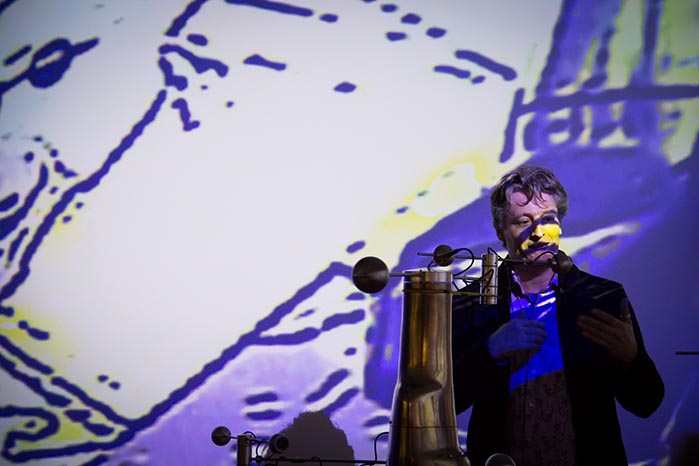Pascal Dufaux’s Machines

Pascal Dufaux with one of his machines. Source: CAFKA.org.
Pascal Dufaux’s machines evoke to my mind the best of science fiction. Their organic yet metallic shapes suggest that they could be probes which have been sent down by an alien civilization. I imagine them falling quietly from the night sky, gently unfurling their legs and antenna-like eyes as they reach their destinations on the surface of the Earth. I imagine that they have been sent to observe and record everything on Earth. To observe it objectively without any emotions or prejudices, democratically flattening all hierarchies that human emotions impose on the act of seeing. These machines find all equally interesting — the human drama, the fly on the wall, the abandoned warehouse, the sounds and sights of an empty landscape.
His machines, in turn, are inspired by the machines that we, as human beings, have sent out into outer space — to roam the surface of Mars, descend into the vortices of Venus, fly past the rings of Saturn, or to reach beyond the boundaries of the Solar System, machines that are infinitely patient as they cross the vast gulfs of space and time, tirelessly seeing and listening. Bathing in the poem of the cosmos just as Rimbaud’s bateau ivre bathed in the poem of the sea.
Yet they send back what they have seen in infrared, ultraviolet and x-ray. And as we see the universe through them, these machines become extensions of our senses. Just as in modern poetry the need for imagery creates a short circuit among the senses of the poet, we expand our capacity to see the universe by blurring the boundaries of our senses. The stunning pictures of gravitational lensing from Hubble Deep Field are also in a sense us “seeing” the dark matter that pervades the universe.
But these scientific instruments also dive deep into “inner space” — electron micrographs that reveal the non-human beauty of the insect world, scanning microscopes that reveal topographies of the landscapes of atomic surfaces of matter, submarine probes that record the unseen drama that for eons has been taking place on the vast continents on the ocean floor.
It is only when we reflect upon the vast adventures of science as a totality that we realize how much of the universe is hidden from our plain view. But there is even more: art reveals to us that even the here and now remains hidden from us. It is as if our brain has made a contract with itself to tune out everything that doesn’t fit snugly with some preconceived notion of reality. Milan Kundera, in his novel Identity, talks about how the eye, seen by the lyrically minded as the window to the soul, is also an inefficient optical device that requires constant lubrication and wiping — a fact that we somehow subtract from our conscious mind. Our ego, our sense of time, separates us from what is present right in front of us by imbuing reality with a tumultuous film of emotions. The project of 20th and 21st century art, from modern to contemporary, is to rip through that lyrical façade and reveal what truly is.
What art in the West conceived as its project, the ancient Eastern ascetics had already been pursuing through long and sustained meditation. It is by that machine-like persistent vision that they peeled away the layers to reveal what lies underneath. In my mind, Pascal Dufaux’s machines touch on something very similar. They have, encoded in their genes, the essence of the expansive scientific curiosity about the cosmos as well as the artistic obsession to discover the essence of the here and now.
Stay a while, sit down or stand, and look. Let the novelty of seeing yourself reflected many times, in time and space, fade away. The spatial distance to yourself is also temporal distance. Empty your mind and let it wander and dwell on the image of yourself distanced from yourself in time and space. Let the machines with their persistent vision reveal to you the hidden and forgotten texture of unadorned time.∗
This essay was first published on CAFKA website in March of 2014.

Leave a Reply